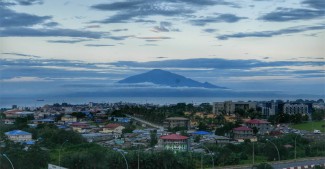What are international institutions pledging in the wake of the pandemic?
The unprecedented COVID-19 pandemic is first and foremost a humanitarian disaster. Expectedly, its effects go beyond the health of populations as it impacts most economies across the globe. For the least developed countries (LDCs), as for others, a swift response is required.
Lessons can be learned from the Ebola crisis in West Africa, where engaging communities quickly was key to containing and stopping the spread of the disease. Beyond this, and national responses to flatten the curve and control the spread of the virus, much needs to be done at the regional and international levels to orchestrate the response and lay the foundations of recovery.
Forecasts for the global economy and trade in 2020 have been revised downwards by the International Monetary Fund (IMF), the World Bank and the Organisation for Economic Co-operation and Development (OECD). Trading partners of LDCs, including the top three (i.e. China, the European Union and the United States), have had to take measures to confine their populations in a bid to curb the spread of the virus. Global trade is therefore being disrupted by factors such as decreasing levels of consumption, restrictions placed on the movement of people, business shutdowns and lower productivity in operations. In addition, foreign financial flows may be shifted away from coronavirus‑affected countries, and there is an underutilization of domestic capital and labour as factories are left idle and people stay at home.
These global supply chain disruptions are impacting LDCs, affecting, for example, textile product exports from Bangladesh and Cambodia where many factories are already closing due to a shortage of raw materials from China. In Cambodia, it has been reported that impacts are significant.
Although countries with tourism sectors will be impacted irrespective of their level of development, in LDCs this impact is likely to compound with other forms of economic and social fragility.
Sharp drops in commodity prices are putting pressure on public budgets, notably in commodity-dependent LDCs. Oil export-dependent Angola, for example, has already declared a state of emergency as its 2020 budget was originally based on oil prices in the region of US$55 per barrel as opposed to US$35 per barrel following the sudden price drop. Elsewhere in Africa, the Zambian economy, which receives approximately 75% of its export receipts from copper, has also been affected. The 2020 decline in China’s industrial output has led to a sudden excess in copper supplies sending the prices of copper tumbling – much to the alarm of exposed countries.
Restrictions in the movement of people, border shutdowns and airline disruptions mean that countries that draw a substantial part of their national income from tourism and its associated services will be severely impacted. This was already the case in 2009 following the financial crisis and H1N1 epidemic as we saw the number of visitors to LDCs and their spending drop. Tanzania, where tourism accounts for 25% of foreign exchange earnings and approximately 17% of GDP, is a case in point. Although countries with tourism sectors will be impacted irrespective of their level of development, in LDCs this impact is likely to compound with other forms of economic and social fragility.
Declining investor confidence, business failures and job losses are raising the spectre of recession. Many LDCs have economies that depend precariously on remittances from diaspora living abroad. World Bank data shows how the percentage of personal remittances to GDP for countries such as Liberia (14.1%), Nepal (28.6%) and Haiti (32.5%) leave them exposed to shocks from reductions in cash being sent home. Unless swiftly offset by fiscal and monetary measures, these global business failures and job losses could also lead to financial sector distress, with implications for trade finance, and LDCs being hit hardest.
So, what are international financial institutions (IFIs) doing?
In March 2020, G20 leaders pledged in a joint statement to use policy tools to minimize the economic and social damage from the pandemic and promised to coordinate fiscal action to restore global growth. National measures are being announced regularly. Alongside this, IFIs have pledged a wide range of measures to support COVID-19 recovery.
The World Bank and IFC approved on 17 March 2020 an increased US$14 billion package of fast-track financing to assist companies and countries. This financing will go to financial institutions to enable them to continue to offer trade financing, working-capital support and medium-term financing. Furthermore, the World Bank is looking to allocate as much as US$160 billion in financial support to aid in economic recovery efforts over the next 15 months.
On 4 March 2020, the IMF released around US$50 billion worth of funds for COVID-19 response efforts for the Fund’s low-income and emerging economy members. Approximately 20% (US$10 billion) of this fund will be made available to its poorest members through a Rapid Credit Facility. The IMF has stated that it stands ready with a total lending capacity of US$1 trillion to assist countries struggling with the humanitarian and economic impact of COVID-19.
Also this month, the African Development Bank (AfDB) raised US$3 billion in a three-year bond to help alleviate the economic and social impact of COVID-19. The Fight COVID-19 social bond, with a three-year maturity, garnered interest from central banks and official institutions, bank treasuries and asset managers including socially responsible investors. This is the largest social bond launched in international capital markets to date. It is estimated that the continent will require many billions of dollars to cushion the impact of the disease, as many countries scrambled contingency measures, including commercial lockdowns in desperate efforts to contain it.
Among other regional developments, the Asian Development Bank (AsDB) has deployed a US$6.5 billion package for its Developing Member Countries to aid in pandemic response efforts. Additional country-specific funds worth US$225 million have been disbursed to countries requiring immediate support. The Islamic Development Bank is setting up a special Strategic Preparedness and Response Facility of US$730 million to mitigate the negative health and socioeconomic impact of COVID-19.
The African Development Bank (AfDB) raised US billion in a three-year bond to help alleviate the economic and social impact of COVID-19. The Fight COVID-19 social bond ... is the largest social bond launched in international capital markets to date.
Elsewhere, the European Bank for Reconstruction and Development (EBRD) has unveiled an emergency €1 billion Solidarity Package of measures to help companies across its regions deal with the impact of the coronavirus pandemic. Inter-American Development Bank (IADB) has injected an additional US$3.2 billion in view of the COVID-19 pandemic. Approximately US$12 billion will be available for IADB members to aid in relief and support efforts. The BRICS Bank/New Development Bank has approved an emergency assistance of RMB 7 billion (approximately US$985 million) to aid in Chinese relief efforts. Notably, this is the Bank’s first assistance program of this kind.
With these efforts and more, it is critical to remember that, in the midst of a rapidly evolving crisis, measures may take months to materialise before they have direct impacts on the recovery process. In the meantime, while many countries are rightly focusing on how to protect the vulnerable in their societies, it is important to remember that LDCs stand to be hit hardest if response and recovery measures are not tailored to their needs.
Trade flows of medical supplies – and medical professionals, which are so critically needed in times of pandemic – must be able to reach LDCs. Humanitarian and emergency aid need to remain responsive through to recovery to ensure that the demand for essential goods and services is met. The magnitude of the recovery required therefore depends on our immediate actions at home and in our communities, to be mindful of protecting those most vulnerable to COVID-19. The recovery, and efforts to make countries more resilient to future pandemics, needs to encompass those economically marginalised populations that Aid For Trade seeks to empower such as women, youth, small businesses, rural populations and citizens of fragile states.
---------------------
Peter Donelan is EIF Coordinator. Théo Mbise and Visvanathan Subramaniam, of the Aid for Trade Unit, World Trade Organisation (WTO), contributed to the piece.
If you would like to reuse any material published here, please let us know by sending an email to EIF Communications: eifcommunications@wto.org.



